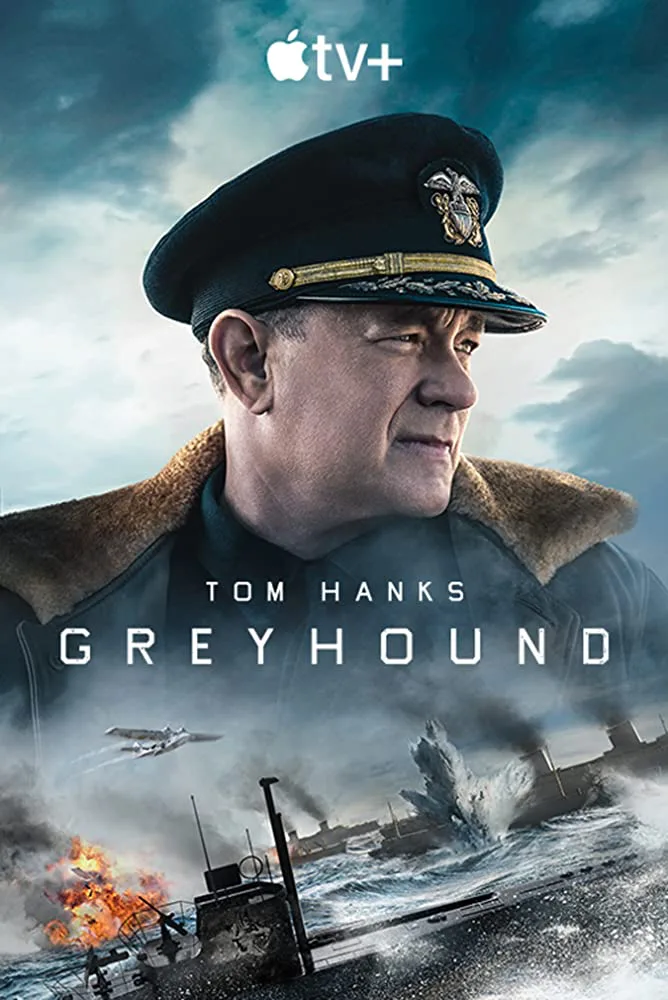Tom Hanks continues his role as a WWII historian with “Greyhound,” an intense Aaron Schneider film that barely plays longer than an episode of the Hanks-produced HBO series “Band of Brothers” and “The Pacific.” At just over 80 minutes if you skip the end credits, fans of this war movie will be drawn to its lean, no-nonsense approach, one that employs more nautical terminology and shouted orders than character detail. For Hanks, who also wrote the film, all you need to know about Commander Ernest Krause is in what he did in service. Sure, Hanks the actor finds a way to inject a subtle glimmer of doubt or fear, but this is one of the most purposeful war movies ever made in how little it offers outside of the naval events that justify its existence. On the one hand, the direct approach is admirable in an era of bloated blockbusters, and there’s something about a simple story of well-told heroism that’s almost refreshing. However, Schneider can’t figure out how to elevate it beyond those minimal intentions, and “Greyhound” starts to become numbing in its tactics, a film whose simplicity feels more shallow than lean. And, yes, there is a difference.
Hanks plays Krause, a career officer who was given command of a destroyer, the USS Keeling (its call sign was Greyhound), which led a convoy of 37 Allied ships across the Atlantic in early 1942. WWII historians know this section of history as the Battle of the Atlantic, a non-stop cat-and-mouse game between Allied ships and German U-boats that spanned the entirety of the war and cost thousands of lives. While Hollywood has produced a great number of films about the ground wars of Europe during World War II, less has been seen about what happened on the Atlantic Ocean, largely because the technical capabilities to really convey the tension of destroyers battling German submarines is relatively new. Perhaps this is what drew Hanks to adapt C.S. Forester’s The Good Shepherd—a sense that he could finally do so in a way that felt genuine.
That last word is clearly the driving focus of both Hanks’ and Schneider’s approach. The character beats in “Greyhound,” including Krause praying over a breakfast provided by head chef Cleveland (Rob Morgan) or discussing strategy with second-in-command Charlie Cole (Stephen Graham), can’t add up to more than five minutes of screen time. The vast majority of “Greyhound” consists of Krause shouting orders about degrees and rudders and other things that will play to Naval historians way more than the average film watcher. The detail is clearly what drives “Greyhound,” and there’s a sense that we haven’t really seen this kind of film before in that no order is skipped over in the screenwriting or editing—in fact, almost every order is repeated from Krause down through the chain of command.
The historical accuracy of “Greyhound” makes it entertaining, but the filmmaking sometimes feels more like a lesson than entertainment. Schneider relies too heavily on his score to raise the stakes and the naval battles aren’t visually interesting enough given how much weight they have to carry. It’s refreshing of Hanks and Schneider to avoid jingoism, but the film’s repetitive nature can make it feel distant. In a theater with the right sound system, “Greyhound” might have been more immersive, but it’s a project that seems destined to suffer by being shuffled off to Apple TV+, even for those with the best home sound system. Much has been made in the last few years about Tom Hanks jokingly being America’s Dad. He doesn’t have the same stories of bad on-set behavior as some of his colleagues, knows more about American history than most teachers, and even yells at people to wear masks. He was Mr. Rogers! And “Greyhound” certainly feels like a film tailor-made for dads of a certain generation—people who don’t want anything overly complicated or nuanced in their stories of heroism. It’s a classic story of someone who would never call himself a hero, but most certainly was one to those he protected on his convoy.
There’s a moment late in “Greyhound” when the naval orders are done, and the human element of Krause’s mission comes cheering to life, nearly saving the film. Not only does Hanks the actor sell this beat with graceful beauty, but it’s really emblematic of the entire reason the project exists and much of Hanks’ career in history-based projects. For years now, Hanks has been reminding us that heroes don’t wear capes and almost never call themselves heroes. Even with the frustrating minimalism of “Greyhound,” it will be a comforting reminder in a time when it feels like we could all use a bit more heroism. And it will probably make you want to call your dad.
Now playing on Apple TV+.




















